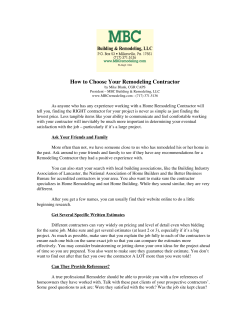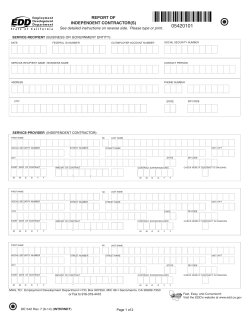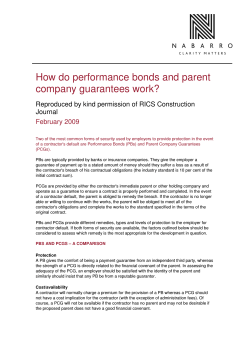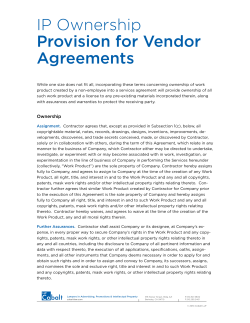
A How to select the right contractors to support your next outage
2007 OUTAGE HANDBOOK CONTRACTOR DUE DILIGENCE How to select the right contractors to support your next outage A critical responsibility of plant managers at the outage planning stage is contractor selection. While it may be tempting to hire one or two major companies with broad experience to handle all work required, this can be risky. A large firm might rate a B+ overall, but what’s its experience base for each of the discrete work packages you have prepared? Consider heat-recovery steam generator (HRSG) repairs. Will the crew assigned to your outage have the specific experience needed to assure a proper job the first time? For example, if P91/T91 welding is required, have the craftsmen made such repairs previously? If not, this may be an area where hiring a specialty contractor is a better business decision. Bill Kitterman, VP/general manager of Bremco Inc (www.bremco. com), Claremont, NH, a national contractor specializing in HRSG services, offered his thoughts on what questions plant managers should ask candidate vendors during the selection process. While some of what he told the editors of the COMBINED CYCLE Journal over a long lunch at the recent Frame 6 User’s Group meeting in Tempe, Ariz, is specific to boilers, most of it pertains to the selection of any contractor. The checklist that follows was compiled from Kitterman’s comments. Company information First step in the due diligence process is to acquire applicable company information, including the following: n Experience. How long has the company been in business? What kind of experience does it have doing the work you require? n Type of company: merit shop or union, or both (directed by separate management teams). n Financial stability. Be sure to pull a credit report on the company, advises Kitterman, and check for any outstanding litigation. Verify insurability, too. You don’t want to hire a firm with a weak line of In your evaluation, be sure to difcredit or one in danger of going out ferentiate between supervisory perof business in the middle of your sonnel and crafts. Length of service, project. formal training, and work experin Mission. Verify that the company’s ence of supervisors is particularly structure and goals are conducive important. For example, service to providing the services you need. time is an indicator of the company’s Is your prospective service pro- health, quality of management, job vider indeed a general contractor performance, etc. At Bremco, superwith the ability to do all the work visors average more than 10 years of required—including new construc- company service; crafts about half tion—or is it a boutique mainte- that. nance firm? Pay particular attention n Collaboration. Is the canto craft skill levels. What didate firm experienced codes are welders qualiin outage planning and a fied to? Does the contractor willing participant in the have millwrights, fitters, outage planning process? iron workers, riggers, etc, To what extent? Did preon staff? Most HRSG work vious work involve coordirequires all of these skills. nation with other contracIn Kitterman’s experience, tors? If so, what was the the more the owner/operaexperience? tor knows about the conKitterman n Evaluation, recommendatractor’s capabilities and tions. Good contractors personnel, the smoother the ask customers to rate their per- planning process and conduct of the formance after job completion and actual job. use this information to continually Quality assurance. Evaluation improve internal processes. Ask of supervisory and craft resources to see these evaluations and any are only one part of the due diligence letters of recommendation. Verify effort. Perhaps just as important to authenticity of all documentation. project success is the support staff n Geographic area of coverage. Be responsible for quality assurance and sure that the prospective contrac- safety. tor has experience doing business Your QA audit, in the specific where your plant is located. case of HRSG work, should focus n Licensing. Kitterman cautions that on knowledge of ASME (American the end user may bear a burden Society of Mechanical Engineers) here. You must fully understand and NBIC (National Board of Boiler what state and local requirements and Pressure Vessel Inspectors) code are with respect to contractor requirements, experience in code licensing. Fallout from using an work, welder qualifications, registerunlicensed contractor could force ing of repairs and work, etc. state authorities to shut down The QA department and its prowork at your site. cedures are particularly important when work involves repair or to boiler pressure parts. A Resource qualification changes plant manager auditing a specialty Average length of service of the contractor for such services wants to contractor’s employees and the skill verify staff capabilities with respect levels of the various tradespeople are to weld inspection, familiarity with important qualification metrics. Kit- the code, accessibility of staff code terman recommends that you ask for experts to field personnel, availand carefully review resumes. Con- ability of QA specialists to monitor tractors worth considering for your repair work, etc. Last thing any work should have them ready for owner/operator wants is to slow your review without asking, he says. down or halt a job while waiting for COMBINED CYCLE JOURNAL, Third Quarter 2006 OH- CONTRACTOR DUE DILIGENCE a weld-quality verification or a code interpretation. Kitterman says Bremco has two QA experts on staff—both certified weld inspectors. Note that some welders also are CWIs. At Bremco, QA staff is responsible for maintaining code stamps (National Board “R,” and ASME “S” and “U” certificates of authorization), promptly answering questions from field personnel regarding what the various codes allow and what they don’t, visiting sites where specialty work—P91/T91 welding, for example—requires their expertise, etc. A quick read of Bremco’s QA procedures points out that while the contractor’s QA manager establishes hold points on boiler and pressurevessel work to ensure that proper procedures are being implemented, the authorized inspector and the client may set additional hold points. Kitterman notes that trust and collaboration between owner/operator and contractor are cornerstones of a successful project. Important to investigate is the contractor’s experience in making repairs and modifications similar to the ones you require. Where possible, you want to avoid having contractor personnel “learn” on your project. Part of this effort is a review of weld procedures and qualifications specific to the work at hand. Project reports. Sometimes overlooked, says Kitterman, is the value of complete, orderly paperwork at the project’s conclusion detailing work procedures followed, welder qualifications, identification of welders with specific welds, materials receipt and test reports, qualitycontrol documentation, applicable drawings, etc. All this, and more, should be archived by the owner/ operator in support of required registration of work conducted, as well as for insurance and other purposes. The diligent contractor will file all applicable paperwork as required by regulatory authorities immediately following job completion. Be sure to check that procedures are in place to make this happen. Using HRSG work as an example, repairs to pressure parts require signoff by an uninvolved third party to verify job integrity. One example: An authorized inspector from an insurance company offering boiler and machinery coverage would supervise a hydro test. Upon successful completion of the test, repair forms and other certifications can be filed with NBIC, state/local jurisdictions, etc. A safe working environment is OH- 2007 OUTAGE HANDBOOK one of the few things on which all people agree. Plants and contractors take particular pride in having “no lost-time accidents.” This, of course, doesn’t happen by accident: It takes thorough training, testing, retraining, record-keeping, vigilance, management commitment, etc. A safety audit is an important part of the plant manager’s due diligence effort. You can get a quick read on a particular company’s commitment to a safe working environment by reviewing its safety manual, suggests Kitterman. It should be a living document—one capable of addressing any and all customer and sitespecific safety requirements based upon sound OSHA (Occupational Safety & Health Administration) guidelines. Names and contact information for members of the company’s safety committee should be in evidence. Further, committee members should be a mix of management and craft personnel. A conscientious contractor will perform an initial job-hazard analysis, continues Kitterman, to address site-specific challenges as well as to incorporate any policies required by the plant owner/operator into the project safety plan. In addition, brief daily meetings for contractor personnel are important for communicating unsafe conditions and changes to the existing safety plan. If you don’t see mention of these actions in a prospective contractor’s safety manual that company may not be your best partner. Also look for words in the manual that openly encourage all employees to monitor their own safety, as well as those around them, and to be proactive. All employees should be entitled to report any unsafe work condition, without reprisal, and if need be to stop the situation until the area can be made safe. Next, carefully check safety training records. At a minimum, all field personnel should be current on OSHA-required training. Ideally, the contractor should have someone on staff capable of teaching the standard 10- and 30-hr OSHA courses to employees and also be able to conduct or supervise other required training—such as forklift operation and confined-space working practices. Latter includes training to pass the so-called pulmonary function test, which qualifies workers to use a respirator and work with it. If your site and/or project have specific safety requirements, verify if contractor personnel are already so trained or will require additional schooling prior to job start. Review of government and insurance records can offer an objective assessment of the candidate contractor’s safety performance. For example companies are required to log work-related injuries and illnesses on OSHA 300 forms and maintain that file. The Experience Modification Ratio (EMR) is another index to check. EMR, an industry factor used in Workers’ Compensation Insurance, is based on an employer’s claim history and determined by the claims paid and reserved in the previous three years along with the audited premiums paid. It is considered a fairly accurate reflector of a company’s safety record, and is often used as a factor for prequalification during a project’s bidding process. An index of more than 1 is indicative of a poorer-than-average safety record; below 1, better than average. Audit of general administrative procedures is important, too. Review procedures for purchase and delivery of job materials as well as for documentation archival. You’ll also want to know the contractor’s job-costing procedures—including the development of line-item budgets and schedules. Keep in mind that a contractor’s ability to continually track project cost is invaluable for on-the-spot evaluation of changes in workscope. Kitterman says Bremco can tell you at 10 am what was spent on your project three hours earlier. Contractor also should have the ability to track job performance by line item so you always know where you stand. Further, a proactive company culture that supports regular morning and evening progress meetings is important. It helps ensure that schedule impacts (positive or negative) are communicated to both contractor and customer personnel. These meetings guard against the “ah shits” that can adversely impact project cost and schedule. With the proper personnel present, they also are a convenient forum for signoffs on change orders. Flexibility in invoice format and in providing the backup documentation required by the customer is another subject to discuss. If after surveying a prospective contractor, you decide the company is qualified to bid on your project, discussion should focus on submittal of a formal qualification package. That documentation should formalize key information identified and discussed during the due diligence effort, such as: past job performance (including COMBINED CYCLE JOURNAL, Third Quarter 2006 GE Solutions Provider State of the Art Triple Modular Redundant, TMR Turbine Controls Supplier & Service Provider Long Term Service and Turnkey Projects Modifications and Upgrades Component Reconditioning Turbine Controls Systems Customer training Field Service Engineering Spare Parts OPC Server Solutions www.global-controls.com budget and schedule actuals vs plan), industry knowledge and experience, safety record, willingness and ability to work with the customer to resolve differences, etc. Comparing vendors Choosing from among several qualified candidates to pick the contractors for your outage work is not an easy task. Both quantitative and qualitative analyses have a role to play in the selection process. The quantitative analysis is probably the easier of the two and can be handled by way of a scorecard developed consistent with the goals of your organization and the job requirements. Your scorecard might be divided into several sections—including experience of key managers, evaluation of resources, project control systems, safety, commitment to total quality performance, etc. To illustrate how this process works, let’s demonstrate how you might objectively rate key managers. Start developing your scorecard by listing the experience categories of importance to your project down the left side of the page. These could include experience on or with: n Projects of similar size and complexity. n Projects with similar logistics. n Local customs and practices. n Conduct of work near operating equipment. n Projects involving labor unrest. n Types of construction planned. n Quality requirements. Next, select the key management positions you will evaluate for each of the experience categories bulleted above. Typically, it would be the project manager, field engineer, craft superintendent, and project controls manager. A numerical evaluation scale might be one where unacceptable qualifications get a 0, marginal a 1, acceptable a 2, and outstanding a 3. Next, draw a simple grid and enter your ratings. Then add up the seven numbers for each key manager. If you rate the value to your project of all managers equally, adding the total scores for each gives you a team score to compare to other companies. However, if you think that all the managers being rated are not created equal and that one or more has greater influence on project success than the others, you should weight the scores accordingly—perhaps a four multiplier for the project manager, a two multiplier for the field engineer, and three each for the craft superintendent and project controls manager. Where such weighting makes sense, you would add the scores for each individual manager as before, but now multiply by the appropriate weighting factor, before summing the numbers for a team score. This same logic would apply to the development of scorecards for other evaluation categories. After adding up all the various scorecards for each of the candidate contractors the top candidates would be identified. Pick the top two or three and initiate your qualitative analysis. Objective of the qualitative analysis is to “get inside the heads” of the top contractor candidates and understand better their cultures and attitudes and what they can bring COMBINED CYCLE JOURNAL, Third Quarter 2006 to the table in the way of innovative ideas and partnering to accomplish your goals within budgetary and schedule constraints. This is particularly important in retrofit/repair projects aimed at correcting a deficiency. Repeating the original usually is not the way to go unless you want to do the same job over again in a few years. The best contractor for your project in this case may be the one that can suggest an innovative solution—one founded on previous experience or on knowledge gained from monitoring similar projects in the industry. Kitterman offered an example. Bremco, he said, was hired to install new feedwater panels in an HRSG firing No. 6 oil and subjected to weekly water washing. The contract called for replacing the damaged insulated steel floor liner with a duplicate of the original. However, Bremco engineers did not see that course of action as a solution to the problem and recommended a refractory floor with the equivalent insulating value—based on its design and construction experience on conventional fired boilers. The customer agreed to the contractual change and has eliminated a maintenance headache. ccj oh OH-
© Copyright 2025









